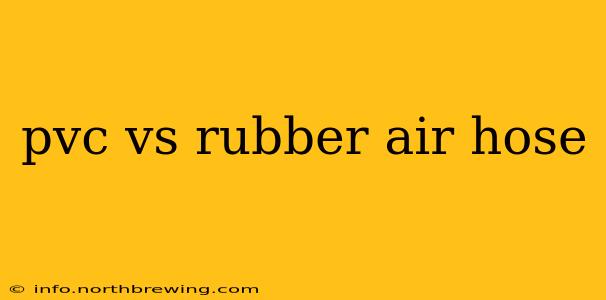Choosing between a PVC and rubber air hose can feel overwhelming, but understanding their key differences will help you select the best option for your specific application. Both materials offer distinct advantages and disadvantages, making them suitable for various tasks. This comprehensive guide will explore the key distinctions, helping you make an informed decision.
What are the main differences between PVC and rubber air hoses?
The primary differences lie in their material properties, impacting durability, flexibility, temperature resistance, and overall lifespan. PVC (polyvinyl chloride) hoses are generally lighter, less expensive, and more resistant to chemicals. Rubber hoses, however, often boast superior flexibility, durability, and resistance to abrasion and extreme temperatures.
What is a PVC air hose best used for?
PVC air hoses are ideal for applications requiring lightweight, cost-effective solutions. Their chemical resistance makes them suitable for use with certain chemicals and solvents, although this should always be verified with the manufacturer's specifications. Common uses include:
- Light-duty inflation: Inflating tires, sports equipment, or other items that don't require heavy-duty pressure.
- DIY projects: Providing compressed air for various home improvement tasks where high pressure isn't critical.
- Low-pressure pneumatic tools: Operating lightweight pneumatic tools, such as small spray guns or airbrushes.
However, their susceptibility to damage from abrasion, extreme temperatures, and sunlight limits their suitability for demanding industrial settings.
What is a rubber air hose best used for?
Rubber air hoses, due to their superior durability and flexibility, are favored for more demanding applications. Their ability to withstand higher pressures and more extreme conditions makes them suitable for a wider range of tasks. These include:
- Heavy-duty inflation: Inflating large tires, industrial equipment, or other items requiring high pressure.
- Industrial pneumatic tools: Operating heavy-duty pneumatic tools like jackhammers, impact wrenches, and sandblasters.
- Construction and manufacturing: Providing compressed air in environments with harsh conditions, such as extreme temperatures or abrasive materials.
The added cost is justified by their extended lifespan and ability to withstand rugged use.
Is a rubber hose more durable than a PVC hose?
Yes, generally rubber hoses are more durable than PVC hoses. Rubber is more resistant to abrasion, punctures, and impacts. PVC can crack or become brittle under stress, especially in cold temperatures or under prolonged sunlight exposure. Rubber, however, retains its flexibility and strength over a wider range of conditions.
Which is better for cold weather use?
Rubber hoses generally perform better in cold weather than PVC hoses. PVC tends to become stiff and brittle in freezing temperatures, making it less flexible and more prone to cracking. Rubber hoses retain their flexibility even in sub-zero conditions, ensuring reliable performance.
What are the main differences between PVC and rubber in terms of price?
PVC air hoses are typically less expensive than rubber air hoses. The lower cost of PVC materials and simpler manufacturing process contribute to this price difference. However, the longer lifespan and greater durability of rubber hoses can offset the higher initial investment over time, especially in demanding applications.
Which hose is more resistant to chemicals?
PVC hoses generally exhibit better chemical resistance than rubber hoses. The specific chemicals each can withstand will vary greatly depending on the exact formulation of the PVC or rubber. Always check the manufacturer's specifications to determine compatibility before using either type of hose with chemicals or solvents.
Which hose is more flexible?
Rubber hoses are typically more flexible than PVC hoses. This inherent flexibility makes them easier to maneuver in tight spaces and reduces the risk of kinks and damage. PVC hoses can be stiffer, particularly in colder temperatures, making them more challenging to work with in some situations.
This detailed comparison should empower you to choose the appropriate air hose for your needs. Remember to always prioritize safety and consult the manufacturer's specifications for detailed information on pressure ratings, temperature limits, and chemical compatibility.
